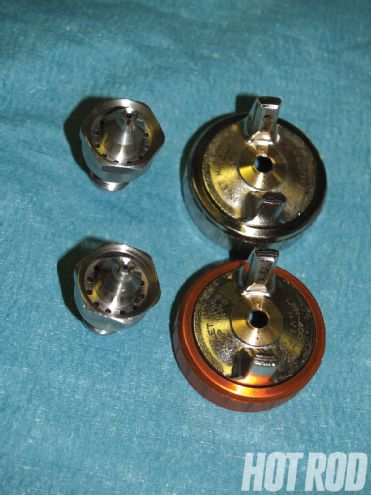
How To Do It
Your mom was right-she knew that when you washed the kitchen floor, if you opened the front and back doors, the floor dried faster. Such is the case with today's high-tech paints. Especially in the case of waterborne paints that are now required in several parts of the country, it's all a matter of airflow and application. If the paint (or your mom's floor) is really dry, the final result is superior quality, and the greater the airflow the better it dries. If you understand that concept, then you're ready to learn more about today's paint offerings. And while waterborne paint may be getting all the buzz, there are still numerous solvent-based paints that can be used even in highly restrictive locations like the East and West Coasts.
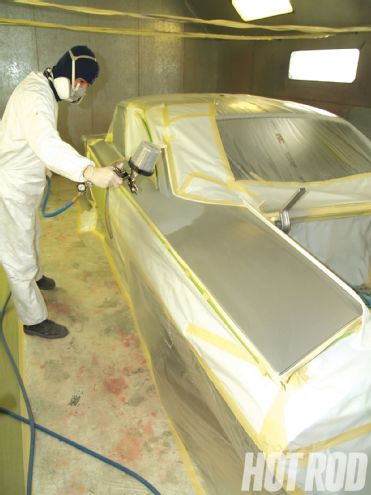 Cotati Speed Shop painter Bobby Thompson applies a basecoat over an area that required repair. This '60 Ford Starliner took 3 gallons of paint. Waterborne paint requires a new skill set to recognize proper application and regulate the proper balance of paint and air. That complexity increases with spot painting. Despite the fact that the paint damage on this Starliner was limited to the area near the side window glass, this entire panel was repainted to blend it with the rest of the previously applied paint.
Cotati Speed Shop painter Bobby Thompson applies a basecoat over an area that required repair. This '60 Ford Starliner took 3 gallons of paint. Waterborne paint requires a new skill set to recognize proper application and regulate the proper balance of paint and air. That complexity increases with spot painting. Despite the fact that the paint damage on this Starliner was limited to the area near the side window glass, this entire panel was repainted to blend it with the rest of the previously applied paint.
The Facts
While the solvent-based paints we have used forever are still legal to spray in most parts of the country, certain counties in California, New Jersey, Massachusetts, and other states mandate only waterborne paint be used because it reduces the emission of volatile organic compounds (VOCs), improving air quality and supposedly reducing the health risk to all involved. For compliance in the restricted areas, the limit is a VOC of 3.5 ppm for basecoats and 2.1 for primers and clears (which are still all old-school solvent-based). While you may not like the change, it's already happened and will most likely spread to other areas soon.
Waterborne paint has become the standard, as 70 percent of all OEM vehicles are now painted with this material. It has been the standard in Europe for a long time, so while the latest waterborne paints are new technology, the concept is neither new nor experimental. In many cases, however, solvent-based paints can be altered to achieve compliance through the addition of other chemicals such as KV1, which is added to Valspar solvent-based paints to lower the dreaded VOC.
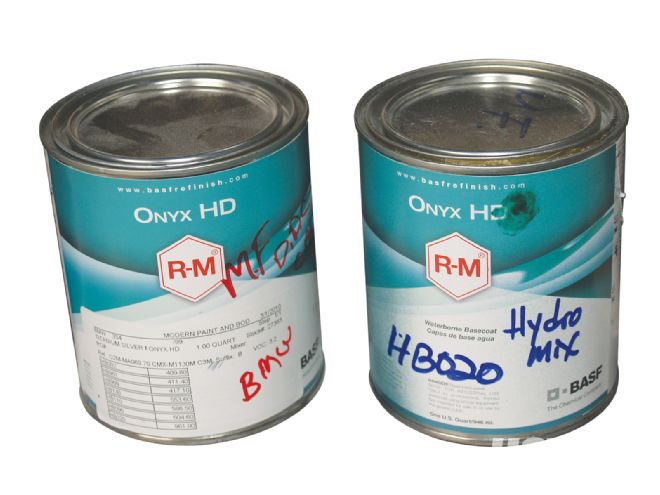
Waterborne paint is exactly what the name implies. Solvent-based paints use solvent to suspend the paint pigments and deliver them to the surface to be covered, while waterborne paints use water.
Zane Cullen, owner of Cotati Speed Shop, uses mostly OEM colors, which are chiefly waterborne as mandated for his Sonoma County, California-based shop. That way he maintains consistent colors for his work rather than going with custom colors that are harder to repair later. While the biggest initial concern with waterborne paint was the availability of colors, the paint makers have released a significant line of colors for the custom builder. Metallic paints and color-matching have improved with the technology. "For custom colors, there are plenty of great quality paints," Cullen says. "But I recommend the two-stage paints to generate the best overall quality and durability."
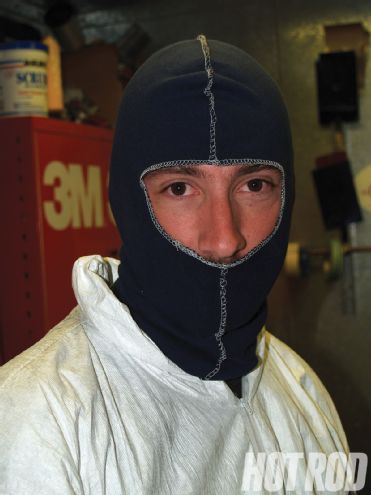 Even with waterborne paint, a head sock like this and full body covering are recommended, and a respirator is still critical gear for anyone in the spray booth. Remember to change the respirator filters often. The paint not only includes toxic chemicals, but the reducers and especially the hardener are also dangerous. This raises the question: Isn't waterborne paint supposed to be better for the environment?
Even with waterborne paint, a head sock like this and full body covering are recommended, and a respirator is still critical gear for anyone in the spray booth. Remember to change the respirator filters often. The paint not only includes toxic chemicals, but the reducers and especially the hardener are also dangerous. This raises the question: Isn't waterborne paint supposed to be better for the environment?
Nearly all waterborne paints use a two-step process-basecoat color covered by a clearcoat. The final surface prep for waterborne paint is similar to older paint: wet-sanding through several different layers of clearcoat with varying grits of paper and then final buffing. Early stages include spraying primer in the standard fashion with solvent-based materials and then a sealer coat that is determined by the choice of base color paint. If there is any question, there are plenty of color guides available depending on the paint you select.
Cullen says, "There are positives and negatives to both paints, and we have had excellent success with our waterborne paints. All solvent paints emit a gas during the curing stages-it's part of the drying process. With waterborne paint, once it dries and the water is out of the basecoat layers, it's done. With solvent-based paints, the gas continues to work through the surface for some time, often six months or more. That means your primer, sealer, basecoat, and clearcoat are all curing together. This gassing out of the paint can appear in the paintjob later and give off a bumpy appearance if the paint is not completely allowed to dry."
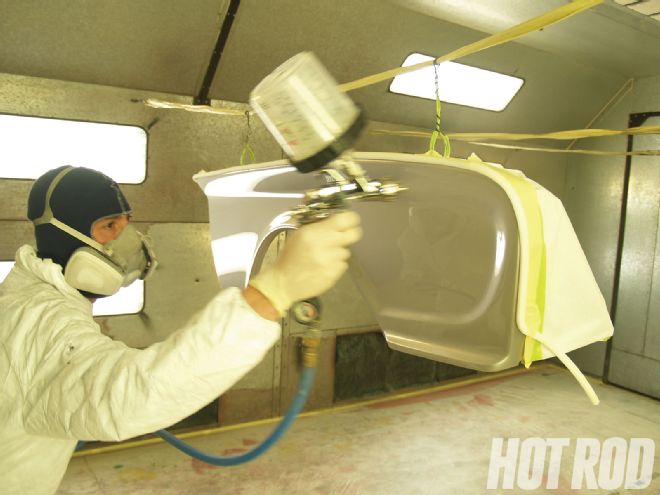 The distance from the surface and the air pressure affect the paint delivery. Nothing is more important, however, than mixing the paint, reducer, and hardener in the right amounts for the conditions, meaning temperature and humidity (read the can and/or manual). Each paint manufacturer has its own requirements for paint application. Most painters use a light coating of clear on the first pass followed by subsequent coatings. The key is to keep a close eye on the process, making sure that no dirt or runs appear that would require starting over.
The distance from the surface and the air pressure affect the paint delivery. Nothing is more important, however, than mixing the paint, reducer, and hardener in the right amounts for the conditions, meaning temperature and humidity (read the can and/or manual). Each paint manufacturer has its own requirements for paint application. Most painters use a light coating of clear on the first pass followed by subsequent coatings. The key is to keep a close eye on the process, making sure that no dirt or runs appear that would require starting over.
An advantage to waterborne paint is it delivers better coverage in fewer coats. Where it would take three to four coats to cover a panel with solvent-based paint, it will only take one to two coats with waterborne, using less material overall. One thing to note is that only the base color coat of the paint system is waterborne; all other layers, including the clearcoat, are still solvent based and sprayed in the normal way. The days of 26 layers of hand-rubbed lacquer are way over-but then again that was always more about bragging rights than quality.
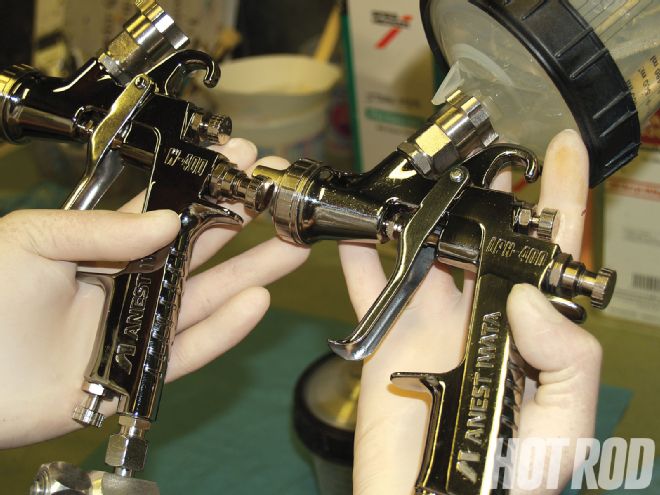 Cullen never mixes his guns. He has one for shooting the basecoat and one for clear. There is a difference in guns based on their purpose.
Cullen never mixes his guns. He has one for shooting the basecoat and one for clear. There is a difference in guns based on their purpose.
One thing you're not going to like is that waterborne paints are expensive, and the entire process costs more than solvent paints. Like health care costs, you're going to see paint costs rise, and that increase is not limited to just the cost of the paint material. If you haven't made the spray booth conversion, you will need a few more things, including a CFM gun (also known as a drier) to help ensure the paint sets up quickly. As the earlier description of waterborne paint implies, these new paints require increased airflow to remove the water from the paint, far beyond the standard solvent-based paints. The use of those guns helps avoid sags and runs, which is the biggest complaint about waterborne paint.
Waterborne paint does not smell as caustic as solvent-based paint, but that does not mean you can spray without protective gear. In fact, just the opposite is true. Despite reduced VOC levels, waterborne paints feature plenty of chemicals that are deadly to humans. A respirator is necessary at all times. In addition, because of slow drying times, the paint lingers in the air longer.
 With the Iwata paint gun system, Cullen uses the gold cap Super Nova gun for his basecoats and the silver cap unit for clearcoats. Basecoat and clearcoat spray guns feature different nozzle sizing to handle the differing viscosities of the material being sprayed. With waterborne spray guns, the internals and nozzles must be water resistant, often made from stainless steel for increased durability.
With the Iwata paint gun system, Cullen uses the gold cap Super Nova gun for his basecoats and the silver cap unit for clearcoats. Basecoat and clearcoat spray guns feature different nozzle sizing to handle the differing viscosities of the material being sprayed. With waterborne spray guns, the internals and nozzles must be water resistant, often made from stainless steel for increased durability.
As mentioned above, waterborne paint is not the only acceptable way to shoot your car today. Most major paint manufacturers offer a low-VOC, solvent-based paint that meets the requirements of the current laws. This high-quality paint offers the same solvent-based urethane paint benefits we've experienced for the past 20 years. As is the case with most paints, there are complete lines of support products designed to deliver the best final results when used with these paints. Mixing and matching paint systems should be avoided. When you start with one type of paint, you need to buy all the stuff that goes with it.
Equipment Required For Waterborne Paint
Waterborne paint performs better with a spray gun designed to work with waterborne materials. The keys are the needle, nozzle, and air cap designs that help atomize the paint properly and internal parts that will not corrode or rust from the water. In addition, the old-style paint strainers will collapse with the new water-based paint because they use a water-based glue to hold them together. Use a 125-micron strainer to capture any dry latex from the container because this stuff will not redissolve in the paint.
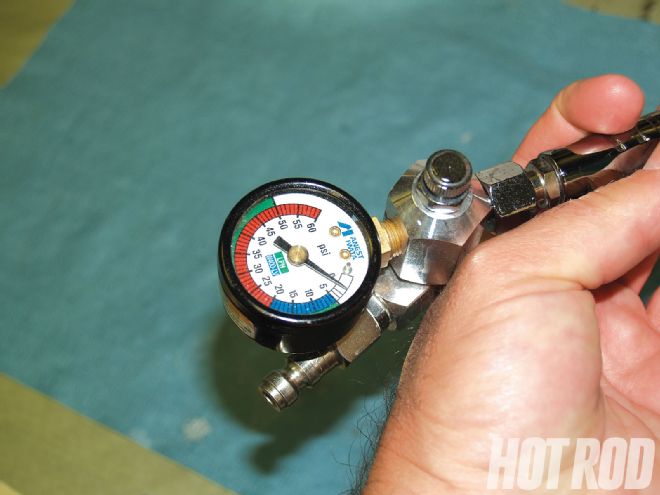 An air pressure gauge on the spray gun is critical to achieving consistent and quality final results. High volume low pressure (HVLP) spray guns work well with waterborne basecoat, clear, primer, and sealer materials. To achieve the right application of paint requires experimentation with different gun air pressures, gun distance from the surface, and proper paint mixture viscosity.
An air pressure gauge on the spray gun is critical to achieving consistent and quality final results. High volume low pressure (HVLP) spray guns work well with waterborne basecoat, clear, primer, and sealer materials. To achieve the right application of paint requires experimentation with different gun air pressures, gun distance from the surface, and proper paint mixture viscosity.
The cleanup process is also different with waterborne paints. Because there are solvents in the waterborne basecoats, they cannot be cleaned with soap and water as you would with home water-based paints. A proper gun wash is perfect for cleaning basecoats, and waste created from the cleanup process needs to be disposed of properly or there will be fines to pay.
A word of caution about the air supply for the spray gun-it has to be clean. Cullen has a classic piston-driven compressor with multiple filters to clean the air. You can never be too clean when it comes to spray gun air.
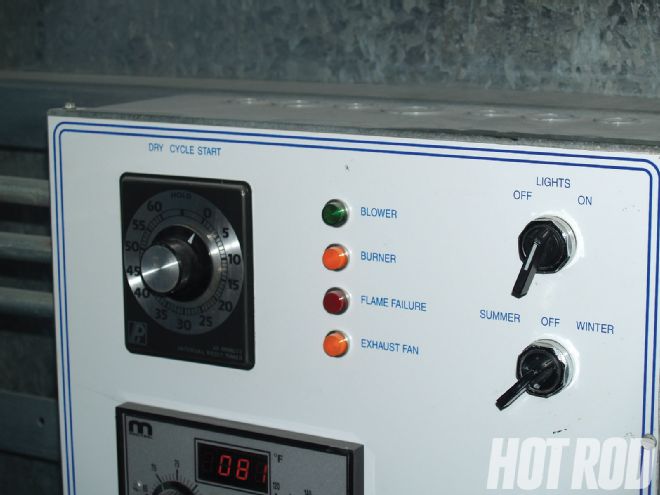 As noted, temperature plays a huge role in the final results. Cotati Speed Shop's paint booth maintains a consistent temperature with a heater that also helps reduce humidity.
As noted, temperature plays a huge role in the final results. Cotati Speed Shop's paint booth maintains a consistent temperature with a heater that also helps reduce humidity.
Cullen uses the Iwata Super Nova Gold cap air gun for the basecoats and a Silver cap spray gun designed for the clear-he never uses his basecoat gun for clear. Cullen says, "If there is any dried basecoat paint in the clearcoat gun, it will end up in your paint. That's an incredibly bad thing if a single drop of blue paint is left in the gun when you are shooting your clear on, say, a white car. And when you are spraying your basecoat, you want the finest spray of paint you can get rather than globules, which result in a poor final appearance."
CFM guns specially designed for pushing dry air at the surface of wet panels are necessary with waterborne paints. When painting an entire car, properly placed dryers will make a big difference in the final quality. The idea is to get the water out of the paint as quickly as possible.
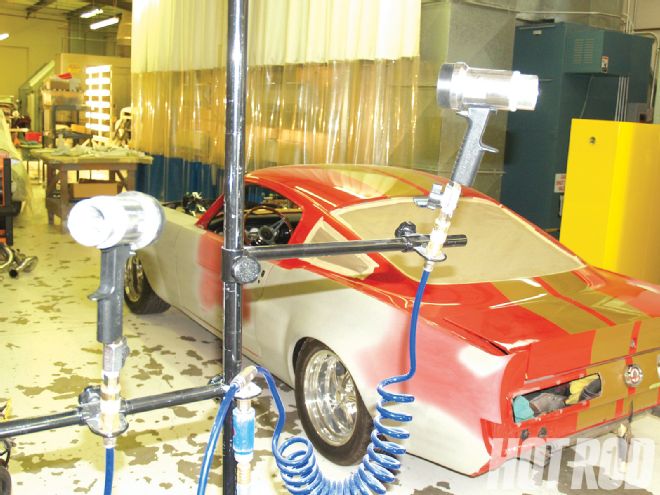 CFM guns (often called dryers) are specially designed for pushing dry air around the surface of the wet panel and are necessary with waterborne paints. They are generally introduced into the booth shortly after the paint has flashed off-around 10 minutes-more quickly if a sag or run is noted, as these guns can help reduce the damage by stopping or avoiding the sag. The key is to not blow the dryers directly at the panel but along the surface to increase airflow in the booth. Remember, you can actually push around the paint and cause surface problems if they blow directly at the wet painted surface. Anywhere between 15 and 30 minutes of drying time with these guns is a good idea.
CFM guns (often called dryers) are specially designed for pushing dry air around the surface of the wet panel and are necessary with waterborne paints. They are generally introduced into the booth shortly after the paint has flashed off-around 10 minutes-more quickly if a sag or run is noted, as these guns can help reduce the damage by stopping or avoiding the sag. The key is to not blow the dryers directly at the panel but along the surface to increase airflow in the booth. Remember, you can actually push around the paint and cause surface problems if they blow directly at the wet painted surface. Anywhere between 15 and 30 minutes of drying time with these guns is a good idea.
For first-time painters and those attempting to spot-in waterborne colors on preexisting solvent-sprayed paintjobs, a noticeable change with waterborne paint is the difference in hue from wet to dry. Waterborne paints look very different when wet due to the latex particles in the paint that give it a blue-green cast that can alarm the shooter. For that reason, color-matching with waterborne paints is done with what is called a control coat method rather than a stick match. If you are attempting to match a current color with a new waterborne paint, you might do well to enlist the help of your paint expert to make sure your final result is satisfactory.
Applying The Paint To The Surface
Waterborne paint needs to be mixed with reducer just like traditional solvent-based paint. However, the primer steps are the same today as they have been for years, but according to Jason Haskins from Valspar Paint, the final surface texture of the sealer coat should be finer than normal solvent-based paint-800-grit is the best finish for the surface before applying the first layer of basecoat. When applying the basecoat, start with a light tack coat and allow it to flash for a few minutes (dry to the touch but not cured). To that surface apply two wet coats of basecoat, allowing them to flash off. Drop the air pressure in half, double the distance you hold the gun from the surface, and apply one final coat with a 50 percent overlap-the final coat should look like a frosted glass. Apply the clearcoats starting with a tack coat and allow it to flash. Apply two more coats of clear (different from some painters-who like more coats) to finish.
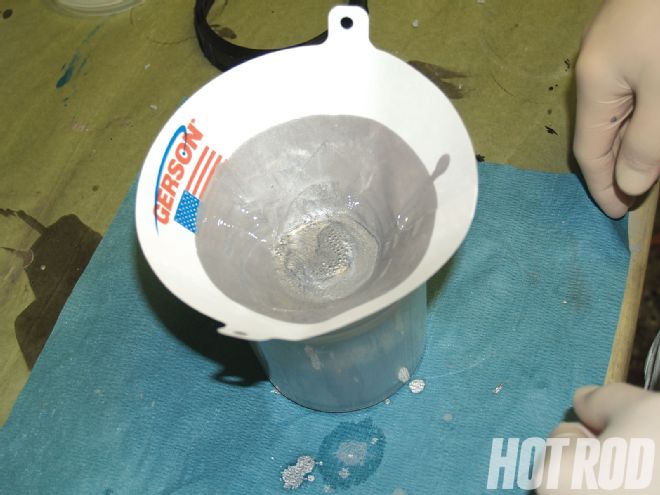 With waterborne paints, even the strainers are different. The standard solvent strainers fall apart as the water-based paint dissolves the glue. Also, because of the thickness of the components found in the waterborne paint, the paint strains slower. Make sure to wait until it is completely strained or you could waste a significant amount of this costly liquid.
With waterborne paints, even the strainers are different. The standard solvent strainers fall apart as the water-based paint dissolves the glue. Also, because of the thickness of the components found in the waterborne paint, the paint strains slower. Make sure to wait until it is completely strained or you could waste a significant amount of this costly liquid.
Jason checks the paint flash by running his fingers along the masking tape. No paint should be left on your fingers.
As for flexible body part painting, it's all a matter of having the right sealer in place. Waterborne works with any material as long the sealer is correct.
Cut And Buff
With high-end shops, the wet-sanding procedure is elaborate. In the same way that a huge amount of time is spent in prepping the body for paint, the show-winning custom shops spend an equal amount of time after the paint and clear are laid down. For Cotati, the process starts with a light cutting of the clearcoated surface with 800-grit paper 24 hours after the clear is sprayed, progressing with several grits until finish-sanding with 3,000-grit paper. The surface is then warmed under special infrared lamps in 15-minute intervals to accelerate the curing process from the metal side out (you can also do this by leaving the panel in the sun to warm). The longer you wait for the paint to dry (Cullen will sometimes wait a week) and then start color-sanding, the better. A wait time of at least 24 hours after the final coat of clear has been applied is generally a rule of thumb minimum.
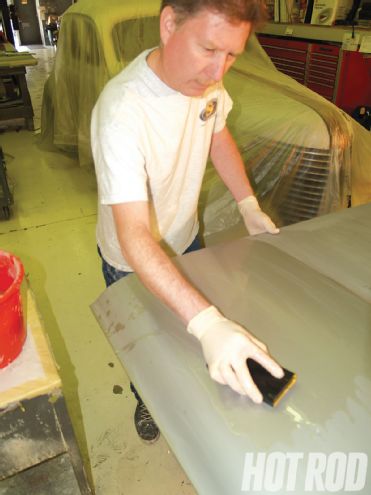 The sanding operation with any paint is unchanged with waterborne paint, since the clearcoat is still solvent based. Cullen's folks are taskmasters with the wet-sanding procedure, starting with 800-grit paper and working through 3,000-grit on each and every painted panel. That means they color-sand the car six times-and you wondered why paintjobs cost what they do these days.
The sanding operation with any paint is unchanged with waterborne paint, since the clearcoat is still solvent based. Cullen's folks are taskmasters with the wet-sanding procedure, starting with 800-grit paper and working through 3,000-grit on each and every painted panel. That means they color-sand the car six times-and you wondered why paintjobs cost what they do these days.
Paint technology marches on and waterborne paints are the result of many advances in materials and applications, but solvent-based paints are still excellent and deliver high quality with easy application techniques, providing they are legal to spray in your area. The parting thought here: Don't fear waterborne paints, as they offer versatility and excellent final results. There are plenty of paint options, but don't expect that to be the case forever.
Pros And Cons Of Waterborne Paint
Pros
• Delivers better coverage in fewer coats due to its higher pigment content
• Reduced mil thickness when dry, which reduces paint pulls when bolting down other body components, such as side mirrors.
• Improved metallic lay-down on body surface.
• Reduced gassing out over time-once the basecoat is dry, it is final. Solvents release gas for several months after application, which can affect long-term paint finish.
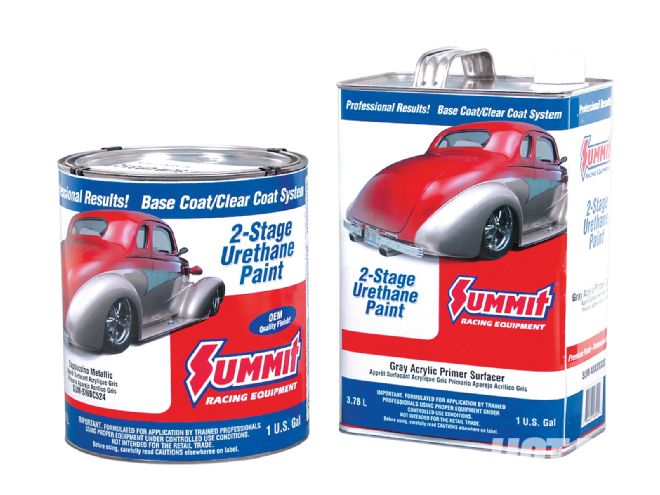 Summit Racing's new lead-free urethane basecoat/clearcoat system is a solvent-based paint that comes in low-VOC applications, so it's legal in California. It includes 40 basecoat colors, plus a line of primers, sealers, clearcoats, reducers, hardeners, and specialty additives as part of the line. Summit offers two versions: Spot/Panel Clear Coat for quick-drying applications on small areas and Overall Clear Coat for protecting an entire vehicle. Both mix in a 4:1 ratio with Summit's 2-Stage System Clear Coat Hardeners. Summit also offers a high-solids urethane clearcoat and hardener formulas rated at just 2.1 VOC with the same gloss, leveling, blending, and buffing characteristics.
Summit Racing's new lead-free urethane basecoat/clearcoat system is a solvent-based paint that comes in low-VOC applications, so it's legal in California. It includes 40 basecoat colors, plus a line of primers, sealers, clearcoats, reducers, hardeners, and specialty additives as part of the line. Summit offers two versions: Spot/Panel Clear Coat for quick-drying applications on small areas and Overall Clear Coat for protecting an entire vehicle. Both mix in a 4:1 ratio with Summit's 2-Stage System Clear Coat Hardeners. Summit also offers a high-solids urethane clearcoat and hardener formulas rated at just 2.1 VOC with the same gloss, leveling, blending, and buffing characteristics.
Cons
• Harder to shoot as it requires a different spray gun and dryers.
• Flash time is critical-it takes longer to dry overall.
• Higher material cost-paints and ancillary products.
• Blending of painted panels is harder, requiring you to learn a new skill set.
• Not a task for home application-a spray booth is required because of slow dry times.